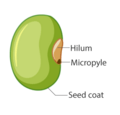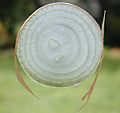Monocotyledon facts for kids
Quick facts for kids Monocotyledons |
|
|---|---|
 |
|
| Daylily flower, with three flower parts in each whorl | |
| Scientific classification | |
| Kingdom: | |
| Division: | |
| Class: |
Monocotyledons
|
Monocotyledons, often called monocots, are a special group of flowering plants. They get their name because their embryo (the tiny plant inside the seed) has only one "seed leaf." This seed leaf is called a cotyledon. It's like the first little leaf that helps the seedling grow.
Scientists group plants into different categories. The APG II system recognizes monocots as an important group, or "clade," of plants.
Contents
What Makes Monocots Special?
You can often tell if a plant is a monocot by looking at a few key features.
How to Spot a Monocot
One easy way to recognize a monocot is by its leaves. Monocot leaves usually have long, parallel veins. These veins run straight up and down the leaf, like stripes. Think of a blade of grass or a corn leaf. In contrast, other plants, called dicots, have veins that look more like a complex net.
Another clue is the plant's root system. Monocots typically have a fibrous root system. This means they have many thin roots that spread out like a mat, rather than one main taproot.
Examples of Monocots
Many common plants are monocots. This group includes:
- All kinds of grasses, like the ones in your lawn or fields of wheat and corn.
- Beautiful flowers such as lilies, orchids, and irises.
- Important food crops like rice, oats, and sugarcane.
- Tall palm trees, which are often found in warm climates.
Images for kids
-
Allium crenulatum (Asparagales), an onion, with typical monocot perianth and parallel leaf venation
-
Roystonea regia palm (Arecales) stems showing anomalous secondary growth in monocots, with characteristic fibrous roots
-
Illustrations of cotyledons by John Ray 1682, after Malpighi
See also
 In Spanish: Monocotiledóneas para niños
In Spanish: Monocotiledóneas para niños







